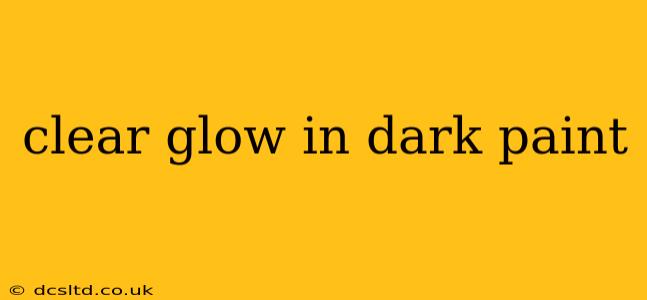Glow-in-the-dark paint has come a long way. No longer relegated to childish projects, it's now a sophisticated tool used in everything from artistic endeavors to safety applications. But achieving a truly clear glow can be tricky. This guide delves into the science behind glow-in-the-dark paint and provides tips and tricks to maximize its luminosity and transparency.
What Makes Glow-in-the-Dark Paint Glow?
The magic behind glow-in-the-dark paint lies in phosphors. These are special materials that absorb energy (usually ultraviolet or visible light) and then slowly release it as light over time. The longer the paint is exposed to a light source, the brighter and longer it will glow. Different phosphors offer varying glow durations and colors; however, achieving a clear glow requires careful selection.
How to Get a Clear Glow-in-the-Dark Effect?
The key to a clear glow isn't just about the phosphor itself; it's about the entire formulation of the paint. Here's a breakdown of factors to consider:
-
Phosphor Concentration: More phosphor generally means brighter glow, but too much can make the paint opaque. Finding the right balance is crucial for a clear, luminous effect. Experimentation is key!
-
Binder Selection: The binder holds the phosphors together. A transparent binder is paramount for achieving a clear glow. Some binders, while clear on their own, might slightly cloud the glow. Acrylic binders are commonly used but their transparency varies depending on the specific product and its concentration.
-
Substrate Preparation: The surface you're painting on greatly impacts the final result. A smooth, clean surface allows for even paint application and maximizes the glow. Rough surfaces can scatter the light, diminishing the clear effect.
-
Application Technique: Thin, even coats are essential. Thick coats will scatter light and reduce transparency. Consider applying multiple thin layers to build up the luminosity without sacrificing clarity.
What are the Different Types of Glow-in-the-Dark Paints?
Glow-in-the-dark paints are available in various forms, each with its own characteristics:
-
Acrylic-based: Commonly used and relatively easy to work with. They offer decent glow durations and are readily available. Transparency is highly dependent on the formulation and the application.
-
Water-based: These are typically less vibrant than acrylics but can be easier to clean up. Transparency is again dependent on the formulation.
-
Solvent-based: Often provide a brighter, longer-lasting glow, but require more care in handling due to the solvents used.
How Long Does Clear Glow-in-the-Dark Paint Glow?
The duration of the glow depends on several factors, including the type of phosphor used, the charging time (exposure to light), and the paint's formulation. Generally, you can expect anywhere from a few minutes to several hours of afterglow, depending on the chosen product.
What are the Best Brands for Clear Glow-in-the-Dark Paint?
Several brands offer glow-in-the-dark paints with varying levels of transparency and luminosity. Researching reviews and comparing specifications will help you find the best option for your project.
Can I Make My Own Clear Glow-in-the-Dark Paint?
While possible, creating your own glow-in-the-dark paint requires specialized knowledge and access to phosphors, which can be difficult to obtain. Pre-mixed paints are generally easier and more reliable for most users.
What are the Applications of Clear Glow-in-the-Dark Paint?
Clear glow-in-the-dark paint opens up a variety of creative and practical applications:
-
Artistic Projects: Creating luminous artwork, enhancing existing pieces, or adding a unique touch to decorative items.
-
Safety Markings: Improving visibility in low-light conditions on pathways, stairs, or emergency exits.
-
DIY Projects: Customizing everyday objects, adding a glow to furniture, or creating unique lighting effects.
This guide provides a comprehensive overview of achieving a clear glow with glow-in-the-dark paint. Remember that experimentation is key to finding the perfect balance of brightness and transparency for your specific project. By carefully considering the factors discussed, you can unlock the full potential of this versatile material and create truly stunning results.
